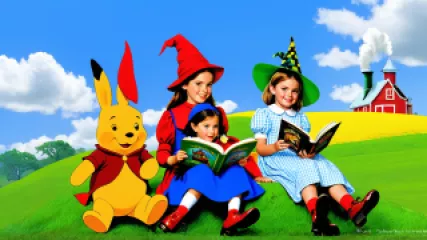7 Kid-Friendly Lessons About Resilience From Classic Children's Stories
7 Kid-Friendly Lessons About Resilience From Classic Children's Stories
As parents, we all want our children to develop resilience – the ability to bounce back from life's challenges and setbacks. While we could lecture our kids on the importance of grit and perseverance, sometimes the best lessons can be found in the pages of their favorite books and movies.
In this article, we'll explore 7 powerful resilience lessons that children can learn from classic children's stories. By unpacking the themes and characters in these beloved tales, we'll uncover practical strategies for building emotional strength and adaptability in our kids.
1. The Little Engine That Could: Believe in Yourself
The classic tale of The Little Engine That Could is a beloved story that teaches children the power of positive thinking and self-belief. When a train full of toys and treats breaks down, a small blue engine volunteers to take it over the mountain, despite the doubts of the larger, more powerful engines.
As the little engine chugs up the steep incline, it repeatedly chants the iconic mantra: "I think I can, I think I can." Through sheer determination and an unwavering belief in its own capabilities, the little engine succeeds in completing its mission, delivering the much-needed supplies to the children on the other side of the mountain.
This story offers a valuable lesson in resilience for kids: when faced with a challenge, it's essential to maintain a positive mindset and trust in your own abilities. By modeling this self-assurance, children can learn to approach obstacles with a "can-do" attitude, persevering through difficulties and ultimately achieving their goals.
2. Matilda: Use Your Strengths to Overcome Adversity
In Roald Dahl's whimsical tale Matilda, the young protagonist faces a daunting challenge: her parents are neglectful and cruel, and her school principal, Ms. Trunchbull, is a tyrannical bully. However, Matilda possesses a remarkable gift – the ability to move objects with her mind.
As Matilda navigates these hostile environments, she learns to harness her extraordinary telekinetic powers to stand up to the adults who seek to oppress her. Whether it's using her abilities to play pranks on her parents or ultimately defeating Ms. Trunchbull, Matilda's resilience shines through as she taps into her unique strengths to overcome adversity.
This story teaches children that resilience often lies in our ability to identify and leverage our own unique talents and abilities. By empowering kids to recognize and cultivate their strengths, we can help them develop the confidence and resourcefulness to face life's challenges head-on.
3. The Wizard of Oz: Surround Yourself with a Support System
In the timeless classic The Wizard of Oz, Dorothy and her companions – the Scarecrow, Tin Man, and Cowardly Lion – embark on a perilous journey to the Emerald City, seeking the help of the Wizard to solve their respective problems.
Throughout their adventure, the group faces numerous obstacles, from the treacherous Yellow Brick Road to the wrath of the Wicked Witch of the West. However, by sticking together and supporting one another, they are able to overcome these challenges and ultimately achieve their goals.
This story underscores the importance of having a strong support system in building resilience. By surrounding ourselves with caring, empathetic individuals who can offer encouragement, guidance, and practical assistance, we can develop the emotional fortitude to weather life's storms.
For children, this lesson is particularly important, as they often rely on the support of their family, friends, and trusted adults to navigate the ups and downs of growing up.
4. Charlotte's Web: Find Strength in Unexpected Places
In the beloved story of Charlotte's Web, a young pig named Wilbur faces the threat of being slaughtered for his meat. However, he is saved by the extraordinary efforts of a spider named Charlotte, who weaves words of praise about Wilbur into her web, captivating the farmer and the community.
Despite her small size and the fact that she is often overlooked, Charlotte demonstrates immense resilience and determination in her quest to protect Wilbur. Her willingness to use her unique abilities – in this case, her web-weaving skills – to help her friend in need serves as a powerful example of finding strength in unexpected places.
This story teaches children that resilience can come from the most unlikely sources. By encouraging kids to look beyond the obvious and recognize the hidden strengths and capabilities of themselves and others, we can help them develop a more expansive and adaptable mindset when facing challenges.
5. Harry Potter: Embrace Your Differences
In the magical world of Harry Potter, the young protagonist faces a daunting challenge: navigating the wizarding world while grappling with his identity as the "Boy Who Lived." Throughout the series, Harry is forced to confront his unique abilities, his tragic past, and the expectations placed upon him by the wizarding community.
Despite the immense pressure and adversity he faces, Harry's resilience shines through as he learns to embrace his differences and use them to his advantage. Whether it's harnessing his natural talent for Defense Against the Dark Arts or drawing strength from his loyal friends and allies, Harry's journey teaches children that resilience often lies in our ability to celebrate and leverage our unique qualities.
By encouraging kids to embrace their own unique strengths and quirks, we can help them develop the confidence and adaptability they need to navigate the challenges of growing up.
6. The Velveteen Rabbit: Persevere Through Hardship
In the timeless tale of The Velveteen Rabbit, a young boy's beloved toy rabbit embarks on a journey of transformation, ultimately becoming "real" through the power of love and perseverance.
Despite facing numerous trials and tribulations, including being discarded by the boy and facing the threat of being burned, the Velveteen Rabbit never gives up. Through his unwavering resilience and the steadfast devotion of the boy, the rabbit is able to overcome these obstacles and achieve a profound sense of purpose and belonging.
This story teaches children that true resilience is not about avoiding hardship, but rather about the ability to persevere and grow through it. By showing our kids that setbacks and challenges are a natural part of life, and that they have the inner strength to overcome them, we can help foster a deep sense of resilience that will serve them well throughout their lives.
7. Winnie the Pooh: Find Joy in the Journey
In the whimsical world of Winnie the Pooh, the beloved bear and his friends face a wide range of challenges, from Pooh's insatiable hunger for honey to Eeyore's perpetual gloominess. Yet, through it all, they maintain a sense of wonder, playfulness, and resilience that inspires both children and adults alike.
Despite the ups and downs of their adventures in the Hundred Acre Wood, the Pooh characters demonstrate that resilience is not just about overcoming hardship, but also about finding joy and contentment in the journey. Whether it's Pooh's ability to savor the simple pleasures of life or Tigger's boundless enthusiasm, these characters teach children that a positive, lighthearted attitude can be a powerful tool in the face of adversity.
By encouraging our kids to embrace the spirit of Winnie the Pooh and his friends – to find delight in the everyday, to cherish their relationships, and to approach challenges with a sense of playfulness – we can help them develop the emotional resilience they need to thrive in the face of life's obstacles.
Unlocking the Power of Resilience Through Classic Children's Stories
As parents, we have the unique opportunity to use the timeless wisdom of classic children's stories to cultivate resilience in our kids. By unpacking the themes and characters in these beloved tales, we can uncover practical strategies for helping our children develop the emotional strength, adaptability, and resourcefulness they need to navigate the ups and downs of growing up.
Whether it's the self-belief of the Little Engine That Could, the support system of the Wizard of Oz characters, or the joyful spirit of Winnie the Pooh, these stories offer a wealth of inspiration and guidance for building resilience in our children. By embracing these lessons and weaving them into the fabric of our parenting approach, we can empower our kids to face life's challenges with confidence, creativity, and a deep sense of inner strength.
So the next time you curl up with your little one to read a classic children's story, take a moment to reflect on the resilience lessons it has to offer. You just might be surprised by the profound impact these beloved tales can have on shaping the resilience of the next generation.






